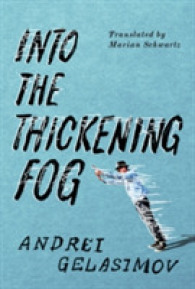Full Description
We want all children to love reading, and Which Book and Why demonstrates how effective guided reading for children in Foundation Stage and Key Stage 1 can help teachers make this happen. Balancing theory and practice, this book explores how schools and teachers can implement guided reading more confidently and more effectively. Which Book and Why draws together the teaching pedagogy underpinning guided reading. The book demonstrates how to develop word-reading skills, reading for meaning, and reading for information. Building on the success and strong foundations of Book Bands for Guided Reading (Baker, Bickler and Bodman, 2007), Which Book and Why:* supports the effective delivery of guided reading for young children in the early stages of learning to read;* helps teachers to choose the right book at the right time, based on focused assessments;* explains how guided reading fits with current theoretical understanding of how children learn;* demonstrates how guided reading works in practice;* outlines how practice may vary, depending on the choice of text, teaching objectives, and the needs of the child;* provides guidance for school subject leaders and senior managers, and for teachers' self-study.Which Book and Why includes in the accompanying CD-ROM a fully searchable database to support schools and teachers in choosing the most appropriate books at the right level for each group in a class. The database includes a full listing of colour-banded titles, including those from recently published series, allowing teachers to use their existing libraries more effectively while also informing decision-making about new resources. In parallel, teachers can search the database for texts that will complement the teaching progression of mainstream phonic programmes, review programmes that are available, and search for a text to consolidate teaching of particular phonemes.Which Book and Why offers professional development resources in each section; self-study activities for teachers - including student teachers, newly qualified teachers, and staff new to guided reading; resources for literacy subject coordinators; and resources for senior management and leadership teams to support the implementation of high-quality and effective guided reading lessons.
Contents
B O O K C O N T E N T SFOREWORD by Roger BeardINTRODUCTION. The rationale for Which Book and Why; How this book works: layout and organization; What's new about this publication?PART 1: GUIDED READING -- THEORY AND PRACTICE. Text Reading in the Key Stage 1 classroom; A theory of learning; What is reading?; Seeking and interpreting evidence for teaching; Measuring progress in a complex theory of reading; Errors are important for teaching; Reading for pleasure; The guided reading lesson structure; Professional development opportunities.of phonics in guided reading. Section B: Implementing good practice; Initial assessment; Gradient of challenge in teaching phonics; The demands on oral language; Supporting materials; Planning for a guided lesson to develop word-reading skills. Section C: Professional development.Theory of reading continuous text; Making meaning in early reading; Guided reading -- developing meaning in fiction; The research base for guided reading as a structural approach; Introduction to a colour-banded gradient of challenge. Section B: Effective guided reading -- implementing good practice; Efficient classroom organization; Initial Assessment. Section C: Professional development.Introduction; What do we mean by non-fiction texts What's the difference? Reading for information; Genre theory; Teaching reading of non-fiction in guided reading; Boys and non-fiction; Reading non-fiction at home. Section B: Effective guided reading to develop reading for information -- implementing good practice. Initial assessment. Section C: Professional development.REFERENCESD I S C C O N T E N T SDatabase of guided reading titlesDatabase of phonics titlesPART 1Professional development opportunities: Grid sheet: Some important distinctions between shared, guided, and independent reading in a literacy lesson; Cards for Activity 1; Handout: -- essential elements of a guided reading lesson; Guided reading: A planning guide; Guided reading -- school self-evaluation PART 2 UNIT 1Professional development opportunities: Handout: Evaluating texts to develop word-reading skills; Planning sheet: Guided reading to develop word-reading skills; Handout: Guided reading to develop word-reading skills: Questions to consider; Handout: The strategy check to promote word-reading skills; Guided reading record sheet -- word-reading skills.Assessing word reading skills: Facilitator's notes; Handout: Observing children interacting with decodable texts; Guided reading record sheet -- word-reading skillsPART 2 UNIT 2Professional development opportunities: Is it worth a lesson? -- evaluation grid; Effective teaching decisions grid; Handout: Teachers' prompting guide; Banding a book -- five criterion-referenced judgements.Assessing literacy knowledge: Facilitator's notes; Assessment Pack: (Alphabet knowledge instruction page, alphabet chart and letter ID scoring sheet; Word reading instruction page, high-frequency word chart, word list record sheet; Word writing instruction page; Dictation and Sentences instruction page, dictation reference sheet; Awareness of print concepts instruction page).Running records of text reading: Session 1: Taking running records of text reading: Facilitator's notes; Running record scoring conventions. Session 2: Scoring running records of text reading: Facilitator's notes; Handout: Running record analysis sheet; Handout: Completed running record sheet for 'No Running!'; Handout: Accuracy rates and conversion chart; Blank running record sheet. Session 3: Analysing and interpreting running records of text reading; Facilitator's notes; Handout: 'No Running!' Unanalysed; Handout: Completed running record sheer for 'No Running!; Blank running record sheetPART 2 UNIT 3Professional development opportunities: Handout: Features of non-fiction texts; Handout: Guided reading to develop reading for information: questions to consider; Key Stage 1 Reading for information checklist; Book banding descriptors, bands 1 to 11; Series reviews: Phonically decodable texts -- Introduction; Reviews of series of readers contained in mainstream phonics programmes (x 5 series); Reviews of series of decodable readers (x 18 series); Banded texts -- Introduction; Full reviews (x 14 series); Brief reviews (x 14 series). Sample lessons, bands 1 to 10; Reading to develop word reading skills: Phase 2 (non-fiction); Phase 2 (fiction); Phase 3; Phase 5Resource materials:Colour-banded progression; Progression of text reading through Key Stage 1; The guided reading lesson sequence; The strategy check to promote reading for meaning; About labels; Blank label templates





